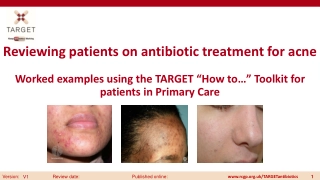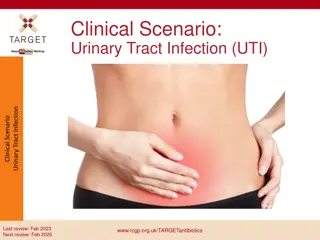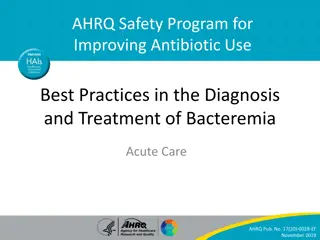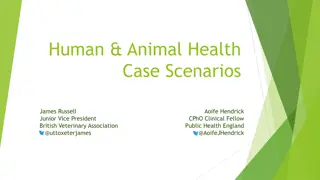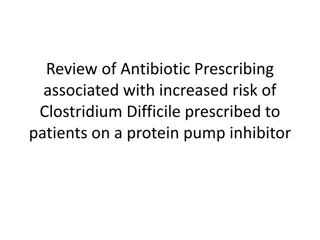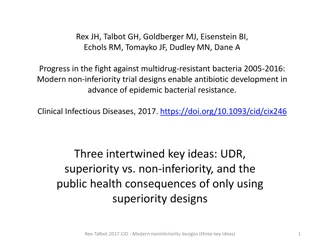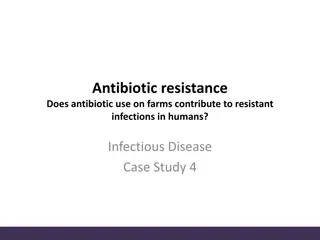Innovating Antibiotic Research & Development: The POWER Act Impact
Increased investment in antibiotics and overcoming barriers to development are crucial to combat rising antibiotic resistance. The PATH Act aims to rejuvenate antibiotic R&D by addressing challenges such as competition for funding, limited pipeline drugs, and difficulty in conducting trials due to acute infections. Initiatives like the GAIN Act and BARDA funding are supporting the development of differentiated antibiotics like Solithromycin, which could offer new solutions for bacterial pneumonia, bioterror threats, and pediatric use.
Download Presentation

Please find below an Image/Link to download the presentation.
The content on the website is provided AS IS for your information and personal use only. It may not be sold, licensed, or shared on other websites without obtaining consent from the author. Download presentation by click this link. If you encounter any issues during the download, it is possible that the publisher has removed the file from their server.
E N D
Presentation Transcript
How the PATH Act Can Rejuvenate Antibiotic R & D July 2015 PRABHAVATHI FERNANDES, PhD Founder, President and CEO
Need to Increase Investment in Antibiotics GAIN Act helps Antibiotic Developers DEMAND for NEW ANTIBIOTICS: Increasing Antibiotic Resistance to Generic Drugs New Regulatory Guidance, Increased Development Efforts, Increased Pharma Interest VOLUME SUPPLY of NEW ANTIBIOTICS: Few Products Approved / In Development TIME [ 2 ]
Barriers to Antibiotic Development Competition for investment dollars with drugs that are taken chronically and do not cure In contrast, antibiotics are acute care drugs which cure in 5-10 days With increasing antibiotic resistance, it is important to get the treatment right, the first time Failure with older antibiotics could cost lives There are only a few drugs in the pipeline to meet unmet needs Antibiotic trials are difficult to enroll as these are acute infections, that Must be treated quickly Prior antibiotic exposure can confound results Mortality from underlying disease can confound results Although antibiotic resistance is increasing, large clinical trials, limited to resistant bacteria, are not possible Therefore the PATH Act is needed to assure a supply of new antibiotics for patients with multi-drug resistant pathogens WSJ Aug 1, 2012 [ 3 ] 3
Two Differentiated Antibiotics in Late Stage Clinical Development SOLITHROMYCIN Oral, IV and Pediatric suspension - Bacterial Pneumonia TAKSTATM Refractory Bone and Joint Infections and Skin Infections 1st Phase 3 trial is complete 2nd Phase 3 trial has completed enrollment Founded - 2006 Phase 2 complete $430MM raised NDA expected 2016 Phase 3 being initiated IPO 2012 Nasdaq: CEMP $ cost to date $ to date [ 4 ]
Funded by BARDA BARDA has provided a life-line of support to develop antibiotics to several companies Solithromycin for use in the event of a bioterror threat Pediatric use Solithromycin could provide protection against bioterror pathogens for children upon approval Solithromycin is the first antibiotic in 28 years for respiratory tract infections. It is being developed as oral capsules, intravenous and pediatric suspension to provide convenience and dosing flexibility for children [ 5 ]
Cost of Development Not Favorable to Investment Cost of two Phase 3 trials for Solithromycin $140MM Large Phase 3 trials can take 3 years - runway for investor risk is too long Development up to Phase 3 cost $60MM Large trials are expensive time and cost and simply not possible for multi-drug resistant bacteria Limited revenue Cost PATH Act Could make it economically feasible to develop antibiotics and importantly make it feasible to conduct trials for antibiotics targeting limited populations of resistant pathogens [ 6 ]
Streamlined Antibacterial Drug Development Streamlined drug development for antibacterials implies using the totality of data from In vitro activity - Efficacy and pharmacokinetics and pharmacodynamic data in animal models (PK/PD) - Translational medicinal chemistry Clinical trials data against resistant pathogens and in scientifically valid infections - Limited use could be expanded after years of clinical experience about 4 years - Companies can work with FDA and health care providers in a systematic fashion to gather data that could lift this restriction Larger trials will continue for drugs that do not address limited numbers of drug resistant pathogens [ 7 ] 7
Streamlined Trials: Advantages and Disadvantages Advantages: Lower cost, shorter time to be available for patients, extended patent life, makes it feasible to develop drugs for multi-resistant pathogens that are currently not common Disadvantages: Less clear clinical data, unclear safety, off-label use The real question is Does streamlined development for limited use compromise efficacy/safety data? Physicians have learned to effectively use the older antibiotics that were approved with streamlined development in spite of safety issues with each of them Running large clinical trials is not the only way to reveal safety issues Without the PATH approach effective antibiotics will not be available for some patients with life-threatening infections - This is a far greater risk than those posed by streamlined development [ 8 ] 8
Managing After Approval of Antibiotic in a Streamlined Program Must be restricted for use within a narrow indication (limited use) How to limit use: - Penalty to company if marketed off label This law already exists Proposed solution to managing safety risk - Companies are already set up for post marketing surveillance systems - Surveillance can be conducted as for orphan drugs or drugs for rare diseases o Surveillance is a key part of PATH - Hospitals can be responsible for minimizing off-label use stewardship programs - CMS has just announced stewardship programs for long term facilities similar programs for acute care hospitals are expected - Physician education is an important tool to avoid inappropriate off-label use Awareness of limited population labeling - If the plan is to expand use then the product must be tested in a wider population - Evaluation of benefit/risk on an ongoing basis by an independent body of physicians/hospitalists/pharmacists [ 9 ] 9
Appropriate Pricing Appropriate pricing will benefit economics and stewardship and drive investment in Antibiotic R & D Premium pricing will help make up for limited use Premium price will decrease use delay future antibiotic resistance Premium pricing will ensure that LPAD drugs are used only for patients with unmet needs These are acute care drugs for unmet needs, minimizing access concerns from premium pricing [ 10 ]
We look forward to your support for the PATH Act Thank you! [ 11 ]


